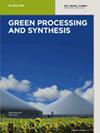抗坏血酸介导的硒纳米粒子作为潜在的抗高尿酸血症、抗氧化、抗凝血和溶栓药物
IF 3.8
4区 工程技术
Q2 CHEMISTRY, MULTIDISCIPLINARY
引用次数: 0
摘要
硒(Se)是一种重要的微量元素,参与控制氧化应激和炎症性疾病。痛风性关节炎是由于单钠尿酸盐(MSU)结晶堆积引起的关节和组织内的炎症和疼痛。本研究旨在探讨抗坏血酸介导的硒纳米粒子(A-SeNPs)的抗痛风、抗氧化、抗凝血和溶栓潜力。研究人员采用了不同的分析技术来研究 A-SeNPs 的形成。使用 MSU 晶体溶解、尿酸(UA)降解测定和黄嘌呤氧化酶抑制(XOI)等方法对纳米粒子的抗痛风潜力进行了研究。A-SeNPs 以浓度依赖的方式表现出卓越的抗高血脂活性。据观察,在 20 毫克/毫升-1 的测试浓度下,A-SeNPs 能显著击碎和溶解 MSU 晶体,使尿酸降解率达到 67.76%。同样,A-SeNPs 的 XOI 为 76%,IC50 为 140 µg-mL-1。此外,通过多种抗氧化试验评估发现,A-SeNPs 具有相当高的抗氧化活性。最后,研究还发现这种 NPs 具有显著的抗凝血和溶栓潜力。因此,A-SeNPs 具有强大的抗高尿酸血症、抗氧化、抗凝血和溶血栓活性,是未来生物医学应用的理想选择。本文章由计算机程序翻译,如有差异,请以英文原文为准。
Ascorbic acid-mediated selenium nanoparticles as potential antihyperuricemic, antioxidant, anticoagulant, and thrombolytic agents
Selenium (Se) is an important trace element that is involved in controlling oxidative stress and inflammatory disorders. Gouty arthritis is the inflammation and pain within the joints and tissues caused due to the accumulation of monosodium urate (MSU) crystals. This study aimed to investigate the antigout, antioxidant, anticoagulant, and thrombolytic potential of ascorbic acid-mediated Se nanoparticles (A-SeNPs). Different analytical techniques were used to investigate the formation of A-SeNPs. The antigout potential of the nanoparticles was carried out using MSU crystal dissolution, uric acid (UA) degradation assay, and xanthine oxidase inhibition (XOI). A-SeNPs exhibited excellent antihyperurecemic activity in a concentration-dependent manner. It was observed that at the tested concentration of 20 mg·mL−1, the A-SeNPs demonstrated significant breakage and dissolution of MSU crystals and resulted in UA degradation of 67.76%. Similarly, A-SeNPs resulted in 76% XOI with an excellent IC50 of 140 µg·mL−1. Furthermore, considerable antioxidant activity was noted for the A-SeNPs as evaluated with multiple antioxidant assays. Finally, the NPs were found to have significant anticoagulant and thrombolytic potential. Thus, it was concluded that A-SeNPs have potent antihyperuricemic, antioxidant, anticoagulant, and thrombolytic activities, making them an ideal choice for future biomedical applications.
求助全文
通过发布文献求助,成功后即可免费获取论文全文。
去求助
来源期刊

Green Processing and Synthesis
CHEMISTRY, MULTIDISCIPLINARY-ENGINEERING, CHEMICAL
CiteScore
6.70
自引率
9.30%
发文量
78
审稿时长
7 weeks
期刊介绍:
Green Processing and Synthesis is a bimonthly, peer-reviewed journal that provides up-to-date research both on fundamental as well as applied aspects of innovative green process development and chemical synthesis, giving an appropriate share to industrial views. The contributions are cutting edge, high-impact, authoritative, and provide both pros and cons of potential technologies. Green Processing and Synthesis provides a platform for scientists and engineers, especially chemists and chemical engineers, but is also open for interdisciplinary research from other areas such as physics, materials science, or catalysis.
 求助内容:
求助内容: 应助结果提醒方式:
应助结果提醒方式:


